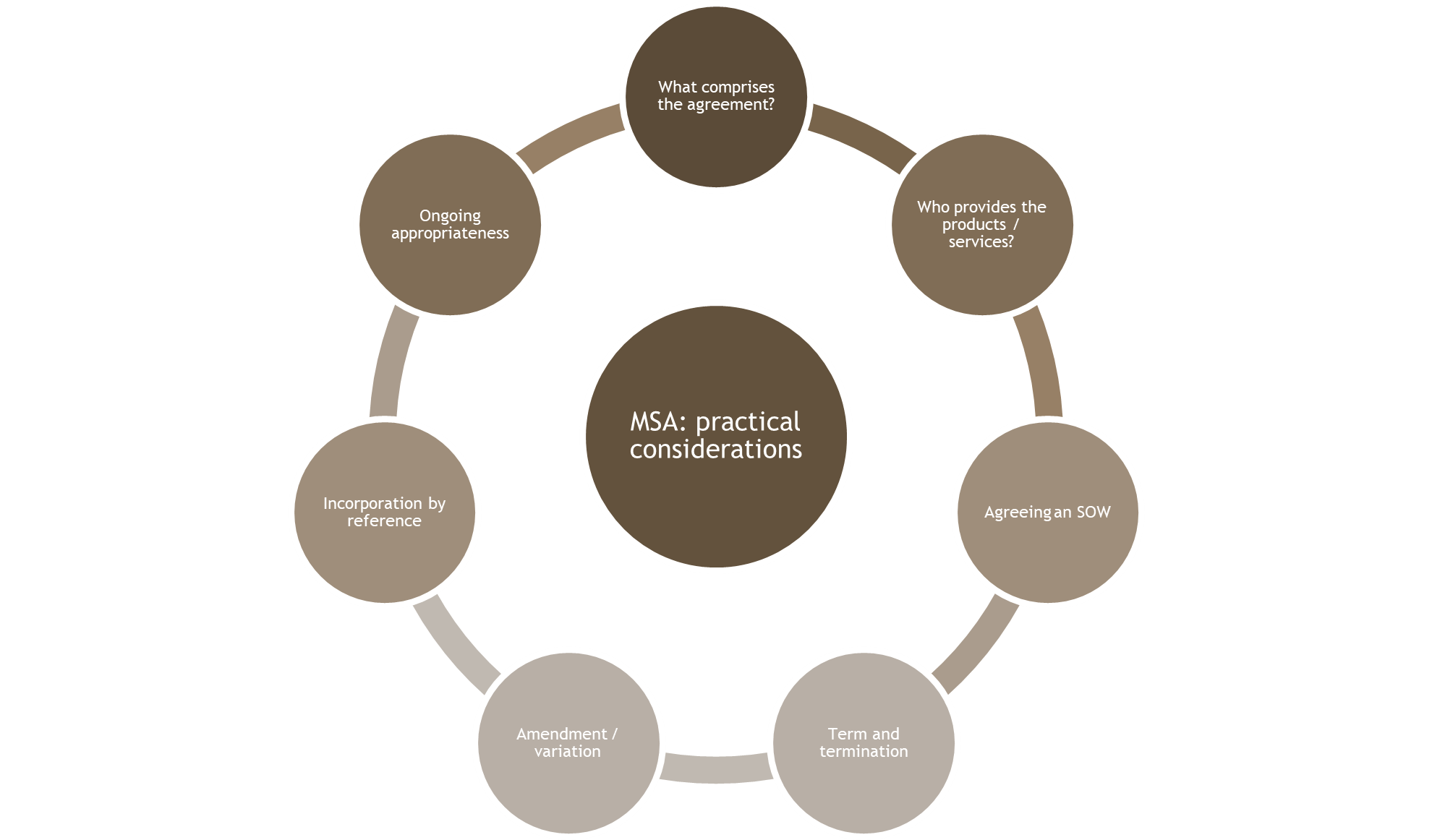Master Service Agreements (MSAs) are a great means to document and manage ongoing business relationships between a service provider or supplier and their customer. In this post, Caroline Hayward and Simon Mee canvass several common, but often overlooked aspects of MSAs that will help if drafting, negotiating or reviewing an MSA.
MSAs: what are we talking about, and why are they used?
Before considering the practical tips, what do we mean by an MSA?
“MSA” is a general term used to describe the agreement that sets out the general terms and conditions governing the parties’ rights and responsibilities. Put simply, it provides the framework for the relationship. The terminology used to describe them can vary depending on the industry, market and content. In addition to terminology, the form and structure will inevitably vary depending on the product/service, delivery channel and client type.
Benefits of MSA include:
- they are useful in situations where there will be repeat work such that each specific item of work or service can be included in a separate document or schedule.
- avoiding unnecessary complexities. This can be achieved by agreeing and clearly setting out an MSA structure that suits the ongoing relationship in a single document, streamlining the arrangement.
- taking away the need to renegotiate and draft each discrete piece of work from scratch. This provides consistency, saving time and allowing focus to remain on the individual services and projects.
Once the MSA is in place, each piece of work, project, product or service can be set out in separate document, whether statements of work, order forms, or other document (SOW).

Practical tips: what to watch out for?
Whilst the MSA structure can be very useful for business relationships, particularly service and supplier arrangements, there are some key issues to keep in mind. We describe some of these below. We do not intend to cover the full gambit of commercial contract issues, but aim to focus on several practical tips that arise with MSA structures.

What comprises the agreement?
As simple as it sounds, often MSAs do not state what encompasses the complete agreement. There should be a term at the outset that articulates what documents form the agreement (e.g. the MSA itself, SOW and any product documentation), and how inconsistencies between the documents are resolved. Is the MSA to take precedence, or does the SOW prevail if there are inconsistencies?
An entire agreement clause should also be included for good measure.
Essentially, it should be easy for a first time reader to understand what documents govern the relationship, and when.
Privity of contract issues
Often products and services are provided by different entities within a corporate group, or the issuer of the product varies in each jurisdiction. It is important to articulate this, and make clear which party is entering into the MSA and what entity is providing a particular service. Carefully considered drafting is needed to be make this clear. The wrong entity can result in contractual issues, but this may also have tax and regulatory implications.
How to agree to an SOWs
The MSA should include a mechanism for agreeing and creating SOWs, including the content expected. It should also be agreed whether each future agreement is incorporated into a single contract with the MSA or if it stands alone as a separate contract.
Ideally, a template setting out the structure and terms of any future agreement can be a useful addition to the MSA.
Term and termination
There are myriad of potential items to consider regarding the term of the agreement:
(a) The parties will need to decide how long the MSA will last, should it have a fixed term and/or be terminated by notice at convenience? This often depends on the business model of the vendor/supplier and bargaining power. For example, a SaaS provider may insist on a minimum subscription term, and not allow termination for convenience.
(b) If there is a clear, defined timeline for a project, the parties should make this clear. Similarly, the parties should consider what happens to the SOWs if the MSA is terminated – do any existing ones continue or do they immediately cease? This will depend on the nature of the work being undertaken. In some cases, the relationship can simply end, but that would not be appropriate if the agreement is to manage a business critical service.
(c) Similar to (b), can a particular SOW, as opposed to the MSA in its entirety be terminated? If so, when?
(d) It is also possible the MSA will not be front of mind, with the SOWs keeping the focus as the arrangements progress. If the MSA has a fixed term, it could expire without the parties realising, and should therefore be kept under review.
(e) Lastly, beware of automatic renewal clauses that mean the term continues automatically for another term at the end of the agreement. These can be convenient but may result you agreeing to inadvertently agreeing to another term. These may be unfair in certain instances.
Amendments/variation
As time passes the parties may want to add to the MSA or need to vary its terms to take account of changing circumstances. This might typically occur when planning a new SOW. Where the proposed variation is inserted needs to be considered carefully: is it specific to only one engagement, or is it a variation that will apply to all engagements? This will affect where it is made. If the variation is simply added into an SOW, it will only apply to that SOW, unless stated otherwise. Even if the intent is to apply the variation to all engagements, it may be forgotten once that piece of work is completed.
Incorporation of terms
A party may sometimes seek to incorporate their own standard terms and conditions, perhaps by hyperlink, to the MSA or SOW. Although this can reduce the length of a document, it can cause problems. If the terms are changed on the website, does that amended version apply to the agreement? Where is the original version, has this been deleted?
If terms and conditions are to be incorporated into an agreement, it can be useful to annex them to the agreement or include a date reference to the terms, so it is clear which terms apply and they can be easily referred to.
Is the MSA still fit for purpose?
One of the benefits of an MSA is that once entered into it sets the basis for the relationship, making ongoing arrangements easier. However, it may be that the relationship and/or services supplied develop or change over time. For example, an initial subscription service might become supported by additional consultancy services.
Changes in the law may also affect the usefulness of an MSA.
An MSA prepared for a particular set of circumstances may become out of date and should be periodically reviewed in the context of the arrangement at date of review. Similarly, if an MSA is subject to many variation agreements it may make the complete document hard to follow such that it may be worthwhile consolidating all the variations into one document – this will ensure that terms and variations withstand the test of time.
Conclusion
Good contract management need not be art: but staying disciplined and vigilant to common pitfalls will assist to mitigate both legal risks (associated with unclear and uncertain agreements) as well operational risks (e.g. missing an auto renewal date or forgetting about variations). Taking the time at the outset to ensure you have a well-drafted and considered MSA will pay dividends in the long run, but also ensuring any amendments and SOWs align with the framework will similarly help to keep legal risk to a minimum.
If you need further guidance or advice on Master Service Agreements, please reach out to your KWM contact or Tim Bednall.









